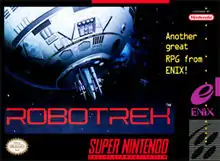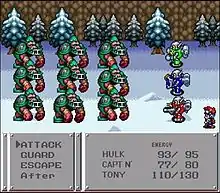Robotrek
Robotrek, known in Japan as Slapstick (Japanese: スラップスティック, Hepburn: Surappusutikku), is a role-playing video game released in 1994. It was published by Enix and developed by Quintet and Ancient for the Super Nintendo Entertainment System.
| Robotrek | |
|---|---|
 North American box art | |
| Developer(s) | Quintet, Ancient |
| Publisher(s) | Enix |
| Director(s) | Masaya Hashimoto |
| Composer(s) | Ayako Yoda |
| Platform(s) | Super NES |
| Release |
|
| Genre(s) | Role-playing video game |
| Mode(s) | Single-player |
As its Japanese name implies, Robotrek was intended as a humorous game. Designed to appeal to a younger audience,[1] Robotrek's main focus is on allowing the player to raise up to three robots which are built from spare parts that may be found, gained through battles, or generated by the player by means of the game's item combination system. Next Generation describes it as a predecessor to the core idea of Pokémon in the sense that the protagonist does not himself fight, but sends out his robots to do so. Like Pokémon, each robot was kept in a capsule, like a ball. However, unlike the aforementioned game, sometimes the player uses "Big Bombs" and the "Weather" ("Weather Mom" in Japanese version) during the battle.
Gameplay
Robotrek has similar gameplay to that of most RPG video games, with the notable exception that the main character is not the combatant; rather, the robots he invents are, making it more similar to Pokémon and Dragon Quest Monsters. The robots are highly customizable, in aspects such as equipment, special attacks, body color and name. The player is allowed to build a maximum of three robots. Unlike many RPGs, the player must invent or create the robots' equipment, use "Program Points" to set the robot's attributes (as opposed to these attributes being set by the game), and program special attacks in a macro-like fashion, although certain commands do special effects instead.
Battles

Battles are engaged by contact with the enemy on a map. The player usually attacks first, unless the enemy has caught the player's side or from behind. Battling in the game takes place on a battlefield under a variation of the ATB system, in which the player must wait for a gauge to fill up before acting. Only one robot may fight at any time up against at most three enemies; the player can switch between robots at the cost of a turn (like in Pokémon). During the player's turn, none of the enemies will act, and the robot is free to move around the battlefield and attack with one of its weapons. After the robot acts, a gauge appears with the letters E (empty) and F (full) at either end. The gauge's depletion will depend on what action the player used. Until the gauge reaches F, all enemies take turns attacking.
Like most RPG video games, the character gains experience points, called here "Megs of Data". Once enough Megs are obtained, the player gains a level. Also all enemies do not give money by default, but certain enemies do drop it on the map after being defeated. Most enemies will drop some item or low-level equipment, but these can be "Recycled" to make money.
This battling system also uses bonuses. The player can earn extra Megs of Data by defeating enemies within a time limit and using melee attacks. Bonus capsules are also scattered around for the duration of the time limit that can contain items or traps.
Inventing
Much of the game revolves around creating and combining items for the robots' benefit, and is essential to make higher-level equipment. The player creates and combines items using an invention machine. More items can be created by finding the "Inventor's Friends" series which can only be accessed depending on the character's level. Aiding the combination process are items called Scrap, these allow the player to create basic equipment or make more powerful ones. Weapons can also be strengthened by combining one weapon with the same type (swords for a Sword). A weapon can increase strength by nine times (called levels). The different Scraps that the protagonist can find, are: Scrap 1, Scrap 2, Scrap 3, Scrap 4, Scrap 5, Scrap 6, Scrap 7, Scrap 8, Scrap 9, Scrap 10, Scrap A and Scrap B.
- Scrap 9 and Scrap 10 when combined with some equipment or other scrap result the most powerful weapons in the game.
- Some inventions, equipment and scraps are not compatible.
Story
On the planet of Quintenix (Paradise Star in Japanese), where the situation has long been peaceful, a group calling themselves "The Hackers", headed by Blackmore, suddenly starts an uprising against the population by disrupting the peace of the town of Rococo (and elsewhere). The main character (who appears to be nameless) is the son of a famous inventor, Dr. Akihabara, who decides to move to Rococo. The main character soon sets off to find out that The Hackers want Dr. Akihabara for a sinister purpose, as Akihabara refuses an offer to join them. The story unfolds to the point where The Hackers' ultimate goal is the Tetron, a mysterious stone that allows viewers to observe events past and future and travel through time.
The Tetron is later found out to be an invention of the main character's ancestor Rask (Rusk) and one of his friends, Gateau, finds the Tetron's potential as the key to controlling the universe by controlling time. Rask disregards that potential and hides the Tetron in shards throughout Quintenix. Gateau, who — presumedly — formed The Hackers later on, obtains the Tetron and attempts to proceed with his plan for universal domination, starting with Rask's home planet of Choco (Chocolate Star in Japanese). It is up to the main character to stop Gateau in his space fortress.
Connection with other games of Quintet
Due to story it is lighter than the other Quintet titles, many fans do not include Robotrek in the Quintet saga, however the game is a parody of the company's themes; such as It is creation and destruction, human ambition, the use of science for good and evil, the theme of immortality that is implicit in Nagisa an assistant android with the resemblance to the deceased mother of the protagonist, problems between neighbors and among others. In addition to having some elements found in the other games of the company:
- The "Blade 4", in the Japanese version is called "Soul Blade" (ソウルブレイド), which could be the replica of the legendary weapon of the hero of Soul Blazer, with the technique of launching the spirit of the Phoenix
- The form of Tetron (bipyramid) resembles with the "Shrine of the Master" from Soul Blazer.
- In the Clock Tower of Count Polinky's mansion where there is an enmity of some dolls with the mice of the place, this part of the game could be a reference to Soul Blazer in parody form.
- In the Japanese version, the chicken on the farm is called "Catherine" (カトリーヌ), which is made a small mention in Terranigma.
- On Robotrek "Rococo Town" (ロココ町) is a reference of the art style that originated in Paris in the late 17th and early 18th century. In Terranigma Ark buys for 800 Gems: "Rococo Apartment" (ロココアパート).
- In the computer of the Hero's house and that of his father, mentions ActRaiser 2 and Illusion of Gaia (in the Japanese and American version)
- Robotrek is one of the games that appears in the Quintet Quiz of Neotokio in Terranigma in the Japanese version.
- In both the Japanese and American versions, a girl's dog and her grandmother's have the name Turbo (タ ー ボ), a name given to the dog that appear in Soul Blazer, Illusion of Gaia and Terranigma.
"The Untold History of Japanese Game Developers: Volume 1"
In the book: "The Untold History of Japanese Game Developers: Volume 1", Koji Yokota one of the developers of Actraiser, Illusion of Gaia, The Granstream Saga and Robotrek, who although he did not mention it in his answer, is knows he was the one who designed the robots and enemies of the game, was interviewed by John Szczepaniak the writer of this book. Fragment of the interview: JS: "Fans regard Soul Blazer, Illusion of Gaia, Terranigma and Granstream Saga, as a loosely connected four-part saga".
KY:"Yes, I tnink there was a common custom or threadshared among the games, in terms of scenario writing, such as like the delivery of the dialogue, and soon.So in the effect I think there was some resemblace. Starting with ActRaiser, and followed by Soul Blazer and Illusion of Gaia, the games are difinitily connected, in Miyazaki-San's mind, at least. Whereas Terranigma and Granstream Saga are some what different.Because I was the one who came up with the basic idea for Granstream Saga.I don't know about Terranigma though."
JS:"I suppose when someone likes all the games from a company, they want to draw connections".
KY: "Yes.I can understand that, because as a fan it's exciting to discover connections or relationships between the characters and contents of the games".
JS:"ActRaiser is part of a trilogy with Soul Blazer and Illusion of Gaia?"
KY:"Yes, I think like you said there are resemblaces among the three games, bacause Miyasaki-san kind of liked the idea of having a god versus demon, in which the main character is on the side of the god and battles demon.That is the underlying concept the he likes to adopt, which unites those three games.He liked to grapple with the themes of creation and destruction in order to create drama. I think Miyasaki-san became very popular because he was able to come up with a convincing script, incorporating pathos, or kind of sadness into it."[2]
Apparently the official trilogy consists of ActRaiser, Soul Blazer, Illusion of Gaia , while Terranigma, The Granstream Saga and the other Quintet games, among them, Robotrek, are only found in the same Quintet universe.
Reception
| Aggregator | Score |
|---|---|
| GameRankings | 66.75% (4 reviews)[3] |
Quintet reported that the game sold 45,000 copies in Japan and 20,000 copies in North America.[4]
GamePro assessed that Robotrek "unsuccessfully attempts to push the envelope of its genre." They described the graphics and audio as especially generic for RPGs, and criticized the inability to send more than one robot into battle at a time and the trial and error involved in creating hybrid weapons and items. However, they did praise the robots' special attacks and the ability to avoid encounters with enemies.[5] Electronic Gaming Monthly's review team scored the game a 7.4 out of 10, with Mike Weigand commenting that "Building your robot is a very cool idea, and there are several areas to explore and people to talk to. I just wish there was a little harsher tone to the whole thing."[6]
See also
Notes
References
- Kaiser, Joe (July 8, 2005). "Unsung Innovators". Next-Gen.biz. Archived from the original on 2005-10-28. Retrieved 2010-04-02.
- Szczepaniak, John (2013). The Untold History of Japanese Game Developers:Volume 1. ISBN 9780992926007. Retrieved 2019-07-08.
- "Robotrek Review Score".
- "Quintet Game Library". Quintet.co.jp. Archived from the original on 2007-09-28. Retrieved 2009-01-11.
- "Robotrek". GamePro. No. 75. IDG. December 1994. pp. 200–202.
- "Review Crew: Robotrek". Electronic Gaming Monthly. No. 65. Sendai Publishing. December 1994. p. 38.